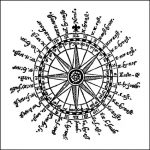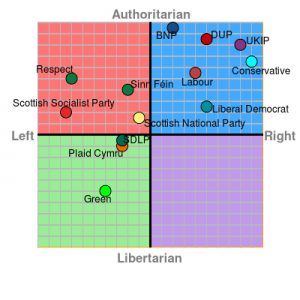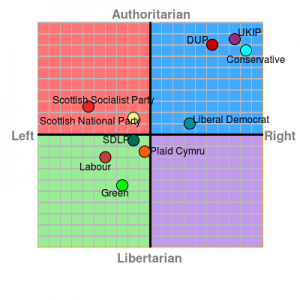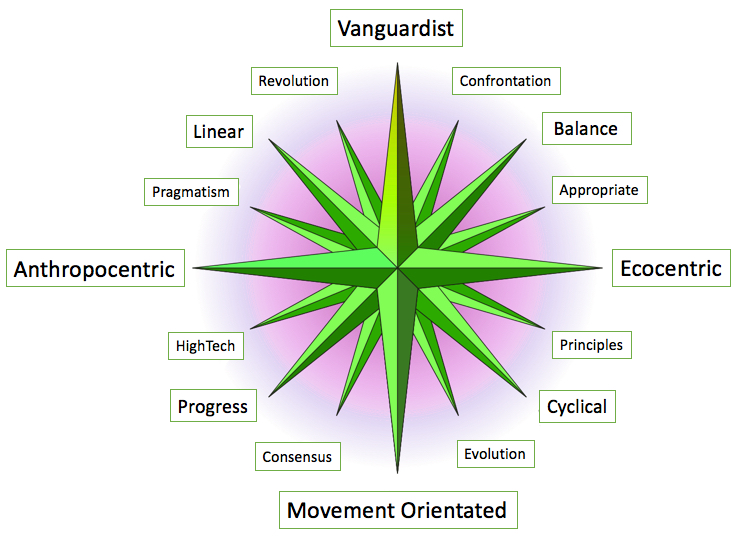 Boxing the compass is a sailor’s exercise where all 32 points of the mariner’s compass are named in clockwise order starting from North. On board ship it is essential for everyone to be using the same technical language without pause for thought in order to communicate essential information.
Boxing the compass is a sailor’s exercise where all 32 points of the mariner’s compass are named in clockwise order starting from North. On board ship it is essential for everyone to be using the same technical language without pause for thought in order to communicate essential information.
As Greens we occupy a unique position philosophically, socially and politically. The green movement itself can be a broad church encompassing different, and sometimes conflicting, points of view. Over time the movement has altered direction in response to changing emphasis on different aspects of the underlying philosophies.
We too need ways to describe our individual and collective position and direction of travel.
Arne Naess uses the analogy of a platform at a station – on the face of it, it doesn’t matter how you got there, you are standing on the platform because you wish to travel in a certain direction. All your fellow travellers have broadly the same desire, however underlying differences get exposed once the means of conveyance and precise route start to be considered.
Conventionally political positions are expressed on a single Left-Right axis, but if we want to look at the differences within the green movement, both present day and historically, this is really not a fine enough instrument. Greens come from all parts of the political left-right spectrum and often do not fit at all comfortably into such a simplified model.
A more sophisticated model is provided by the Political Compass. This uses the left-right terminology to describe an essentially economic position: left equates to more state control of the economy, taxes and redistribution of wealth, whereas right describes a free-market, neo-liberal position of laissez-faire economics with minimal state interference. In the extreme left is economic communism (in the Marxist-Leninist sense) and to the far right is extreme Chicago School Neo-liberal economics.
They then add a second axis vertically running from Authoritarian to Libertarian describing the attitude to social issues; the degree to which the state should intervene in social life. In the extremes authoritarian becomes social fascism whilst libertarian becomes classic anarchism.
This is very useful in illuminating the differences (and similarities) between political party positions. For the 2015 election, their analysis of the various parties positions puts the Green Party uniquely in the centre of the Libertarian-Left quadrant (Plaid Cymru and SDLP just edge in to this area being slightly libertarian and somewhat leftish), with all the other mainstream parties in the Authoritarian-Right area. Interestingly British politics has no Libertarian-Right party.
Now look at what has happened in 2017:

 Political compass puts all the main parties in much the same position with the exception of Labour under Jeremy Corbyn. Now firmly back where they used to be, and very close to the Green position using those two axes.
Political compass puts all the main parties in much the same position with the exception of Labour under Jeremy Corbyn. Now firmly back where they used to be, and very close to the Green position using those two axes.
So the Political Compass puts Labour and the Green Party in a similar position – but what of the Green Compass? Do the attitudes to economics and social issues really define what it is to be green? Are there other dimensions which are more significant? How can we reflect the different positions within the broad green movement in the UK? We may agree on our economic and social positions (even with other political parties like Labour) but have very different underlying philosophies and tactical approaches to current problems.
For historical reasons the Green Party in the UK often fails to represent the wider UK movement – a decision was taken early on in its development during the creation of the Ecology Party to switch from seeking to build a cross (political) party broad green consensus and mass movement, to pursuing electoral success as a means of expressing leadership to the wider movement. Under a different electoral system this could have been a highly successful strategy, but with hindsight it looks like it might have been a mistake.
What we seem to have now is a very fragmented (and arguably less effective than it should be) movement that has singularly failed to achieve most of the goals set out in the early 1970s.
We also have a Green Party that to many appears to have lost touch with what they perceive as its ecological roots – in practical terms a party that is more concerned with social than ecological justice – and that this anthropocentric viewpoint is at loggerheads with the ecological changes that are now playing out.
We are in troubled waters and we need tools to navigate, to communicate both with each other and to express our position to those outside. How do we identify hazards around us and plot a safe passage to our destination? What does the green compass rose look like?
The traditional political compass cardinal points – the Authoritarian / Libertarian social axis and the State / Neo-Liberal economic axis are not very useful in distinguishing key differences within the green movement.
 Mentioned above was the early split in forming the Ecology Party (EP) between those who felt that the EP’s role should be to express the political views of a broad coalition of green organisations (much like 38degrees today seeks to be driven by its participants taking a broadly liberal, as opposed to authoritarian, position) and those who wanted the party to lead the movement – engaging first with the political establishment and using electoral success to gain the support of the wider movement. This “Vanguardist” versus “Movement-Orientated” spectrum might form the first cardinal axis on our compass.
Mentioned above was the early split in forming the Ecology Party (EP) between those who felt that the EP’s role should be to express the political views of a broad coalition of green organisations (much like 38degrees today seeks to be driven by its participants taking a broadly liberal, as opposed to authoritarian, position) and those who wanted the party to lead the movement – engaging first with the political establishment and using electoral success to gain the support of the wider movement. This “Vanguardist” versus “Movement-Orientated” spectrum might form the first cardinal axis on our compass.
Another difference which often comes up in discussion is that between “deep” and “shallow” green thinking. What this distinction seems to be addressing is the attitude towards human beings and the whole earth system. The deep green position sees humanity as merely a part of the whole earth eco-system, whereas lighter greens place more emphasis on human society – a more anthropocentric view.
The anthropocentric tendency leads the Greens to promote social justice, equality and fairness between people over purely ecological concerns. Whatever your position on this spectrum either a Vanguard or a Movement approach might be appropriate. We could use this as the second cardinal axis of our compass.
Now we need to fill in the ordinal points which lie half way between the four cardinal points, and maybe the sub-ordinal as well. There are several candidates:
- Pragmatism vs Principles
Is it right to compromise the message to fit a media agenda and win votes? - Local vs Global
Bottom up or top down? Think global act local – but does that mean we shouldn’t spend effort coordinating globally? - Confrontation vs Consensus.
Should we always work to achieve consensus which may involve compromising with very different agendas? - Hi-tech vs Appropriate Tech
Is “new” “high” technology a good thing, or does Jevrons’s Paradox hold? - Growth vs de-growth
Is “green growth” an oxymoron? - Revolution vs Evolution
Given the timescales of eco-system tipping points is it possible to take society in a sustainable direction without revolutionary change? - Progress vs Stasis/Harmony/Balance
Is progress a good thing, or should we first seek to live in balance with nature? - Linear vs Cyclical time
How do we see time – does it progress in a straight line (time’s arrow) or is the past and future always here in the present? Is time cyclical? - Leadership vs Empowerment
What is the role of a leader? Should we all be leaders? - Federalist vs Centralist
How should an organisation or society be ordered?
These are just some of the possible dichotomies that face us when we think about our position as Greens in a wider social context. They also that differentiate our individual positions within the green movement.
If we use the Vanguard//Movement and Anthropocentric//Eco-centric dimensions as our primary axes we can fit these others around them, considering where each end of these ordinal and sub-ordinal dimensions lies in relation to the cardinals.
Here is one possible way of arranging some of them:
Of course this is just a first attempt at providing a tool to fix our position, to recognise hazards, to see where others are coming from. The full mariners compass has 32 points, here I have only provided 16 – I leave it to others to add more points, and indeed to reorder them if a more logical sequence presents itself.
Now we can start to box the green compass (with the equivalent of the nautical terminology using just the four cardinal points in brackets):
- Vanguardist (N)
- Confrontational (NNE)
- Balanced (NE)
- Appropriate (ENE)
- Eco-centric (E)
- Principled (ESE)
- Cyclical (SE)
- Evolutionary (SSE)
- Movementist (S)
- Consensus (SSW)
- Progressive (SW)
- Hightech (WSW)
- Anthropocentric (W)
- Pragmatic (WNW)
- Linear (NW)
- Revolutionary (NNW)
- Vanguardist (N)
if we take the centre of the compass rose as being the ideal green position you can now think about your personal position on these 8 axes and perhaps can some insight into how best to approach others.
Personally I find myself strongly Ecocentric, slightly Vanguardist, strongly preferring AppropriateTech over HighTech, fairly much towards the Principled end rather than Pragmatic, somewhat Confrontational, strongly Revolutionary, very much taking a Balance rather than Progress position and my view of time is very Cyclical.
The mathematically inclined can make a seven point scale along each of the 8 axes, plot a position on each, and then do some vector arithmetic to plot a single point on the compass to indicate a compound position.
Alternatively, you can go out and talk to people. Or even go and plant a tree.
Roger C-O, 1 May 2017.



Comments powered by CComment